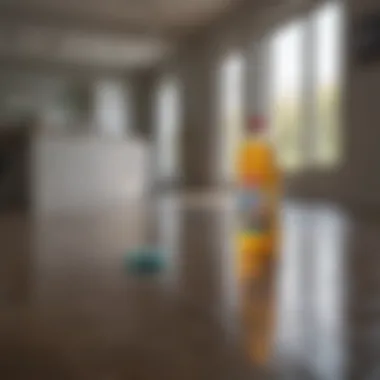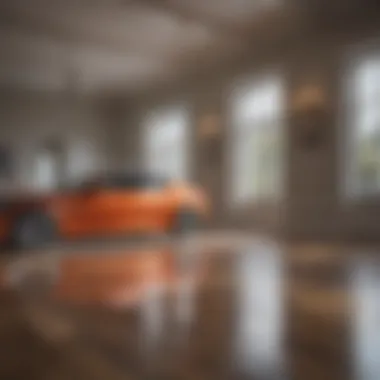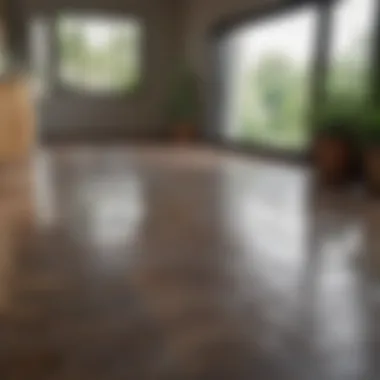Maintaining a Clean Floating Floor: Best Practices


Intro
Maintaining a clean floating floor is essential for both aesthetic appeal and durability. Floating floors are layered flooring systems built to withstand various environmental conditions while providing comfort and style. Understanding the different materials, cleaning techniques, and preventive strategies is vital to preserve their integrity. This article aims to explore various practices for maintaining the cleanliness of these floors and extends to product recommendations and seasonal maintenance tips.
Architectural Inspiration
Floating floors often reflect diverse design styles. They can range from traditional hardwood to modern laminate systems, each offering distinct visual impacts. Having a clear vision of how these styles fit into your interior can aid in the decision process when selecting the right flooring material.
Overview of Design Styles
The choice of flooring often stems from broader architectural themes. For instance, minimalist homes may benefit from sleek, smooth surfaces, while rustic designs might call for textured wood finishes. Understanding how different materials contribute to the overall aesthetic is crucial. This awareness should guide homeowners to select floating floors that not only enhance but also complement their existing architecture.
Innovative Materials and Techniques
New materials and technologies continually emerge in flooring design. Luxury vinyl planks, for instance, offer the appearance of wood or stone but are more resistant to moisture. Such advancements provide various choices according to needs, ensuring that aesthetic preferences do not compromise functionality. Homeowners should stay informed about these developments to make educated decisions regarding flooring options.
Interior Design Trends
Current interior design trends influence how floating floors are approached. Color schemes, textural contrasts, and material combinations create dynamic spaces where floor maintenance can play a significant role in visual coherence.
Color Schemes and Their Psychological Effects
Choosing the right colors for floating floors can affect room perception. Lighter shades create the illusion of space, making a room feel larger and brighter, whereas darker tones can promote coziness. Homeowners should consider how these colors would appear when integrated with flooring materials; this understanding enhances both design choices and floor maintenance.
Space Optimization Tips
Using floating floors effectively allows optimization of space. These floors can be installed over most existing surfaces, eliminating the need for extensive demolition or alteration. Implementing smart arrangements and multi-functional furniture can further enhance room utility. This shines light on the necessity of clean flooring to maintain clarity in space utilization.
Remember: A clean floating floor not only elevates the room's appearance but also extends its lifespan.
Prolusion to Floating Floors
Floating floors represent an innovative option in flooring solutions, providing a practical approach to both installation and maintenance. These floors are not affixed to the subfloor but are designed to float above it. This unique characteristic allows for expansion and contraction, which is crucial in various climates. Understanding floating floors is key to grasping their benefits and maintaining them effectively.
Definition and Characteristics
Floating floors are typically made of several layers, providing durability while maintaining a lightweight structure. They are installed by interlocking the planks or tiles together, creating a seamless appearance without the need for glue or nails. This feature alone offers a significant benefit when it comes to installation, as it is less labor-intensive and allows for quicker project completion. The layers usually consist of a core layer which provides stability, a design layer for aesthetics, and a wear layer for protection against daily wear and tear.
Types of Floating Floors
Floating floors come in a variety of materials, each offering distinct attributes and advantages. Three popular types are laminate flooring, engineered hardwood, and luxury vinyl plank.
Laminate Flooring
Laminate flooring is a widely used choice among floating floors. It is composed of high-density fiberboard topped with a photographic layer that mimics the look of real wood or stone. This versatility in appearance is a key characteristic, making laminate a popular option for homeowners looking for an affordable alternative to more expensive flooring materials. Laminate is also known for its resistance to scratches and stains, which adds to its appeal. However, one should note that laminate flooring is not as moisture-resistant as other options, making it less suitable for areas prone to water exposure.
Engineered Hardwood
Engineered hardwood stands out among floating floor options due to its composition, which includes a top layer of real hardwood and multiple layers of plywood underneath. This structure allows engineered hardwood to offer the authentic look of real wood while being more stable in changing humidity conditions. It can be refinished a few times, extending its longevity. This type of flooring is beneficial for those who desire elegance without sacrificing performance. However, its cost can be higher compared to laminate.
Luxury Vinyl Plank
Luxury vinyl plank is gaining popularity for its exceptional realism and resilience. Constructed with several layers, including a tough wear layer and a photo printed layer, it closely resembles both wood and stone. It is highly resistant to water, making it ideal for kitchens and bathrooms. The ease of installation and maintenance also contributes to its favorable reception among homeowners. On the downside, while luxury vinyl plank offers durability, it may not have the extensive lifespan of hardwood options.
Importance of Cleaning Floating Floors
Cleaning floating floors is essential for several reasons. The cleanliness of these floors reflects the overall hygiene and aesthetics of a living space. Regular cleaning not only enhances visual appeal but also contributes to the health and longevity of the flooring material. This article explores the various benefits associated with maintaining clean floating floors, which include aesthetic appeal, disease prevention, and ensuring floor longevity.


Aesthetic Appeal
A well-maintained floating floor instantly improves the look of any room. Dust, dirt, and grime can accumulate over time, dulling the surface and detracting from its intended design. Keeping the floor clean helps showcase its texture, color, and pattern. This is particularly true for types like laminate, engineered hardwood, and luxury vinyl plank.
When guests visit, the first impression often comes from the flooring. A sparkling clean surface not only enhances the decor but also communicates a sense of care and attention to detail. Regular cleaning routines, such as daily sweeping or vacuuming, ensure that the floor stays visually appealing. Moreover, using the right cleaning methods avoids damage and preserves the original beauty of the flooring material.
Disease Prevention
Another critical aspect of cleaning floating floors is the prevention of disease. Dirt and dust harbor allergens, bacteria, and other pathogens that can adversely affect health. This is especially important for homes with children or pets, who are more susceptible to infections.
Regular cleaning minimizes the accumulation of these harmful substances, thus improving indoor air quality. Techniques like damp mopping can transfer allergens and dust from floor surfaces. By doing so, it promotes a healthier environment. Keeping floating floors clean supports overall well-being, making it a vital practice for any household.
Floor Longevity
Cleaning floating floors also plays a pivotal role in enhancing their longevity. Dirt and debris can act as abrasive agents, gradually wearing down protective finishes or causing scratches on the surface. Ignoring regular maintenance can lead to more severe damage requiring costly repairs or replacement.
Effective cleaning strategies help maintain the floor’s integrity and extend its life. Choosing suitable cleaning products and tools reduces the risk of damage and helps uphold manufacturer warranties. Proper maintenance ensures that the beauty and functionality of the flooring are preserved over time.
"Regular maintenance is key to preserving your investment in floating floors. A clean surface not only looks good but also lasts longer."
Cleaning Techniques for Different Floating Floors
Maintaining the cleanliness of floating floors is essential to ensure their beauty and longevity. The right cleaning techniques can make a significant difference in the durability and appearance of your flooring. This section will explore both daily maintenance routines and deep cleaning methods tailored to various types of floating floors, such as laminate, engineered hardwood, and luxury vinyl plank. Each method has its advantages and requires specific considerations to protect flooring while keeping it clean.
Daily Maintenance
Daily maintenance is crucial for preserving the condition of floating floors. It helps in preventing dirt and dust buildup, which can lead to scratches. Regularly check high-traffic areas for dirt accumulation. The simplest methods include sweeping or vacuuming.
- Sweeping is effective for light dust and debris. Using a soft-bristled broom can help avoid scratches on the floor's surface.
- Vacuuming is more effective in removing fine particles. Make sure the vacuum has a suitable setting for hard floors to prevent damage.
Consistent daily maintenance promotes a cleaner environment, reducing the need for more intensive cleaning later.
Deep Cleaning Methods
Deep cleaning is necessary periodically to remove stubborn dirt and grime that daily maintenance does not address. There are two main methodologies to consider: vacuuming versus sweeping and effective mopping techniques.
Vacuuming vs. Sweeping
Vacuuming and sweeping serve the same purpose but in different ways. Vacuuming is generally preferred on floating floors because:
- Key Characteristic: It removes debris and fine dust effectively and can reach areas that a broom might miss.
- Unique Feature: Many vacuums specifically designed for hard floors include attachments that can avoid scratching the surface.
- Advantages: Vacuuming is faster and does not scatter dust back into the air.
- Disadvantages: If not used correctly, a regular vacuum can cause scratches, so choosing the right model is important.
Using a vacuum designed for hard surfaces is a beneficial choice outlined in this article.
Mopping Techniques
Mopping is integral to deep cleaning floating floors. Correct mopping techniques ensure that floors are cleaned without causing moisture damage that could affect the flooring.
- Key Characteristic: Mopping requires the use of a damp mop, rather than soaking the floor.
- Unique Feature: Microfiber mops are often recommended, as they can trap dirt and are washable for reuse.
- Advantages: They clean effectively without leaving excessive water behind, which is crucial for floating floors that can warp if they absorb liquids.
- Disadvantages: Over-mopping can lead to moisture damage, so it is vital to control the dampness of the mop.
In this article, addressing the right techniques and products becomes essential for those looking to maintain the integrity of their flooring. Regular deep cleaning, alongside daily maintenance, builds a strong foundation for the longevity of floating floors.
Choosing the Right Cleaning Products
Selecting the appropriate cleaning products for floating floors can directly influence their longevity and aesthetic appeal. This choice is about more than just preferences; it entails understanding the specific requirements of the material used. Different flooring types have unique properties that can react variably to cleaning agents. Thus, choosing the right product can prevent damage and preserve the flooring's appearance over time.
Manufacturer Recommendations


Most manufacturers provide guidance on the best cleaning solutions for their products. Ignoring these guidelines can lead to inadvertent damage, voiding warranties or compromising the integrity of the floor. Each flooring type—be it laminate or engineered hardwood—has a specific maintenance protocol to follow.
For instance, manufacturers like Pergo and Mohawk often recommend using pH-balanced cleaners to maintain the finish of their laminate products. Checking the product specifications before making a purchase ensures compatibility and optimal care.
Natural Cleaning Solutions
Turning to natural cleaning agents can be an effective and eco-friendly choice for maintaining floating floors. Products such as vinegar and baking soda are often suggested for their cleaning properties without introducing harsh chemicals. However, it's crucial to use them cautiously. Utilizing a diluted vinegar solution can effectively lift dirt without damaging the finish; yet, it should be rinsed thoroughly afterward. Additionally, essential oils can also enhance the cleaning experience, providing pleasant scents without harsh effects on the flooring.
Commercial Products
The commercial cleaning market offers various products specifically designed for different types of floating floors. Selecting products labeled as safe for laminate or engineered hardwood is vital for effective cleaning. Brands like Bona and Zep specialize in formulations that cater specifically to the needs of these materials. When choosing a commercial product, always consider the following:
- pH Levels: Ensure that the product is pH-neutral to avoid damaging the finish.
- Residue-Free: Select products that do not leave a harmful residue that could attract more dirt over time.
- Surface Compatibility: Verify that the product is formulated for your specific flooring type to avoid adverse reactions.
By understanding the options available and their implications, homeowners can maintain their floating floors in optimal condition, balancing cleaning efficacy with the safety of their investment.
Preventive Measures for Floating Floors
Preventive measures are essential in maintaining the aesthetic and functional qualities of floating floors. These floors are attractive for their versatility and ease of installation but can be vulnerable if not properly protected. By taking proactive steps, homeowners can significantly reduce wear and tear, keeping their floors looking pristine for many years. This section will explore three main strategies, which include using area rugs and mats, protecting furniture, and establishing regular maintenance schedules.
Area Rugs and Mats
Using area rugs and mats is one of the simplest yet most effective strategies to protect floating floors. They act as a barrier against dirt, moisture, and scratches. Placing rugs in high-traffic areas, such as entryways and living rooms, helps to catch debris before it can scratch the floor. Additionally, investing in mats that have a non-slip backing can prevent accidental slips and falls while safeguarding the floor's surface.
The material of the rug is also important. Opt for rugs that are easy to clean and maintain. Natural fiber or synthetic materials can both be good choices, depending on your personal preferences and the overall decor. Regularly vacuuming or shaking out these rugs prevents the buildup of dirt underneath that can lead to potential damage.
Furniture Protection
Heavy furniture can cause scratches or dents on floating floors. Therefore, protecting furniture is crucial in maintaining the floor's integrity. First, consider using felt pads under the legs of furniture. These pads allow for easier movement of items without damaging the floor surface. This step is essential especially for items that are frequently moved, like chairs or tables.
Furthermore, rearranging furniture periodically can also help distribute weight more evenly across the floor, preventing concentrated damage in one area. When placing new furniture, ensure that it aligns with the manufacturer's recommendations to avoid excessive weight that can lead to bowing or damage over time.
Regular Maintenance Schedules
Setting a regular maintenance schedule is key to preventing significant issues from arising. Daily or weekly cleaning routines should be established which include sweeping or vacuuming to remove dirt and debris. This practice can keep dust and grit from becoming ingrained into the floor's surface.
In addition to daily cleaning, deep cleaning sessions should be performed monthly. This may involve using a damp mop with a suitable cleaner that does not harm the floor material. Regularly inspecting the floor for any signs of damage or wear will allow for prompt repairs before they escalate into larger problems.
By integrating these preventive measures into your routine, you not only safeguard your investment but also enhance the overall appearance of your floating floors. Maintaining a clean and well-protected floor contributes to its longevity, ensuring that it continues to add value to your home.
Dealing with Common Issues
Floating floors, while visually appealing and practical, can still face wear and tear over time. Addressing common issues is essential for preserving both the look and functionality of your investment. Understanding how to manage stains, spills, scratches, and scuffs can greatly enhance the longevity and appeal of your flooring. Moreover, being proactive in dealing with these common problems not only prevents escalation but also maintains aesthetic standards in your home.
Stains and Spills
Immediate Actions
When a spill occurs, the swift response can dictate the outcome. Acting quickly prevents deeper penetration of liquid into the flooring material. The key characteristic of immediate actions is their speed; removing a liquid before it sets can avoid permanent damage. This quick remedy is valuable because stains can often lead to more complex repair processes if not addressed promptly.
Immediate actions may include blotting the spill with a clean, dry cloth. It is important not to rub, as this can worsen the stain. If the spill is significant, using a vacuum can help. In a floating floor scenario, where moisture can warp surfaces, timely intervention is crucial.
Advantages include easy execution with common household items and potentially avoiding the need for extensive cleaning later. Disadvantages may arise from inadequate reactions to stubborn stains that could have been eliminated earlier.
Stain Removal Techniques
Once a stain has set, specific techniques need to be utilized for effective removal. The primary contribution of stain removal techniques is to restore the floor to its original condition. Common methods range from using manufacturer-recommended cleaners to natural solutions like a mixture of vinegar and water. The effectiveness of these techniques is enhanced by knowing the material composition of your flooring.
A notable feature of stain removal techniques is their adaptability. Whether it is a water-based or oil-based stain, different products can be used to combat various issues. This versatility makes stain removal techniques a popular choice among homeowners.


However, the uniqueness of every stain means that techniques cannot always guarantee success, leading to potential frustrations and further cleaning efforts.
Scratches and Scuffs
Preventive Solutions
Prevention is key when it comes to scratches and scuffs. Implementing preventive solutions contributes significantly to maintaining the pristine condition of floating floors. The most effective preventive measures include placing felt pads under furniture and ensuring pet nails are trimmed regularly. These solutions not only protect against physical abrasions but also prolong floor life.
A central aspect of these solutions is their proactive nature. They minimize the risk of damage before it occurs. The ease of application and low cost make them manageable for any homeowner.
On the downside, regular maintenance in adhering to these strategies can be tedious but remains vital for long-term floor care.
Repair Techniques
In the event of scratches or scuffs, various repair techniques can be employed to restore the floor's surface. These methods might include using specific floor repair kits or applying wood markers tailored to laminate flooring. Such techniques contribute directly to the aesthetic restoration of the floor.
A major characteristic of repair techniques is their efficiency. Most solutions can be implemented quickly and without the need for professional intervention. Homeowners appreciate the ability to manage minor repairs themselves.
However, some solutions may not cover deeper imperfections or wear and may require additional touch-ups, which can complicate the repair process. Long-term value from these techniques will rely on their application and the material of the flooring.
In summary, understanding how to deal with common issues in floating floors can save time, ensure cleanliness, and extend the life of your flooring investment. With adept handling of stains and scratches through immediate measures and preventive solutions, a homeowner can maintain the integrity and charm of their floating floors.
Seasonal Maintenance Tips
Maintaining a floating floor involves consistent care, but seasonal changes can impact the flooring differently. The importance of seasonal maintenance tips cannot be overstated. Each season brings unique challenges that can affect both the appearance and durability of the floor. By adapting cleaning and care routines to align with seasonal variations, homeowners can ensure their floating floors remain in optimal condition year-round.
Regular cleaning and maintenance are essential, but seasonal adjustments enhance effectiveness and support the overall health of the flooring. This approach helps prevent damage caused by climate-specific issues such as excess moisture or temperature fluctuations. For instance, winter can bring snow and salt into the home, while summer can result in humidity and dirt. Addressing these concerns promptly can minimize wear and tear, expediting the longevity of the flooring investment.
Winter Precautions
During winter months, special precautions should be taken to protect floating floors.
- Moisture Management: Snow and ice can cause water damage if allowed to accumulate inside the home. It is essential to wipe away any moisture quickly. Use absorbent mats at entrances to trap snow and salt.
- Use the Right Products: Avoid harsh chemicals that can damage the floor’s finish. Opt for manufacturer-recommended cleaning products, or create a natural solution using vinegar and water to clean up any spills.
- Humidity Control: Keeping indoor humidity levels manageable can prevent the expansion or contraction of floor planks. Use a humidifier or dehumidifier as needed to maintain stable conditions.
Summer Care
Summer brings its own set of challenges for maintaining floating floors. The heat and humidity can create a favorable environment for dirt and grime accumulation.
- Regular Sweeping and Vacuuming: Dust and allergens can easily settle on the floor. A regular cleaning routine using a soft bristle broom or a vacuum designed for hard floors will help maintain cleanliness.
- Avoid Excessive Heat Exposure: Do not place rugs or carpets directly in sunlight for prolonged periods, as UV rays can fade the flooring color. Utilize window coverings to manage sunlight during the peak hours of day.
- Moisture Control: Just as in winter, keep an eye on humidity levels. Ensure good air circulation and do not allow water to sit on the floor during cleaning. Any spills should be addressed immediately to avoid warping.
Regular seasonal care can significantly prolong the life and beauty of your floating floor. Just a few changes in your routine can make all the difference.
By incorporating these seasonal maintenance tips, homeowners can safeguard their floating floors against the harsh effects of winter and summer. This proactive approach not only preserves the aesthetic appeal but also ensures the functionality and longevity of this integral part of your home.
Final Thoughts
Cleaning and maintaining a floating floor is not just about aesthetics. It is crucial for preserving the integrity and lifespan of the flooring materials. A thorough understanding of cleaning techniques, preventive measures, and regular maintenance contributes significantly to the overall health of the floors. When homeowners take these factors into consideration, they can enhance both the beauty and functionality of their living spaces.
Long-Term Floor Care
Successful long-term care of floating floors involves establishing consistent cleaning routines. Daily dusting or vacuuming will prevent dirt accumulation, while periodic deep cleaning ensures that the floors are unstained and unharmed. Familiarity with the specific requirements of various types of flooring—be it laminate, engineered hardwood, or luxury vinyl plank—is paramount. Each material demands its own unique approach to cleaning. For example, while laminate can endure damp mops, wood often requires drier methods.
Moreover, regular inspections for signs of wear, including scratches and discoloration, can help to identify problems early on. Addressing these issues swiftly may prevent more significant damage down the line.
Investment in Quality
Investing in high-quality floating floors is a decision that can yield considerable benefits. Quality materials are typically more resistant to wear, scratches, and moisture. They also maintain their appearance much longer than poorer alternatives. While the initial cost may be higher, the long-term savings from avoiding frequent replacements or repairs are significant.
When selecting flooring, consider not just the visual appeal but also the durability and maintenance requirements. Researching into various brands and understanding their warranties and care instructions can guide homeowners in making informed decisions. Choosing the right flooring and committing to a maintenance routine ultimately ensures that the investment enhances both the safety and style of a home.
"Quality flooring can transform a space and increase the property value, making it a wise long-term investment."
In summary, taking the time to establish cleaning routines and noting material quality are essential elements in maintaining a clean floating floor. Such practices lead to enhanced aesthetic appeal and prolonged durability.







